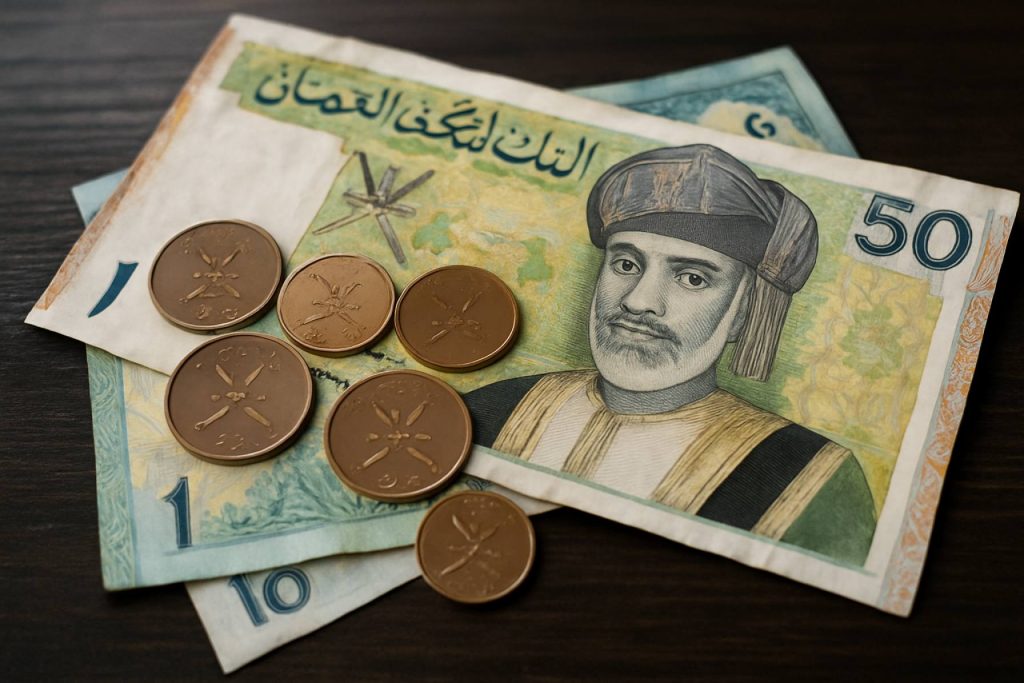
Table of Contents
- Executive Summary: Key Findings and Forecasts
- Overview of Oman’s Currency System and Regulatory Framework
- 2025 Currency Rate Outlook: Projections and Drivers
- Monetary Policy and Central Bank Strategies (cbo.gov.om)
- Global Economic Trends Impacting Oman’s Currency
- Legal and Tax Implications for Currency Transactions in Oman (taxoman.gov.om)
- Compliance Requirements for Businesses and Financial Institutions
- Key Statistics: Recent OMR Performance and Historical Trends
- Risks, Opportunities, and Scenario Analysis Through 2030
- Expert Insights: Future Outlook and Strategic Recommendations
- Sources & References
Executive Summary: Key Findings and Forecasts
The Omani Rial (OMR) remains one of the most stable currencies in the Gulf region, anchored by its longstanding fixed exchange rate regime. Since 1986, the OMR has been pegged to the US dollar at a rate of approximately 1 OMR = 2.6008 USD, a policy reaffirmed by monetary authorities to ensure economic stability and investor confidence. The Central Bank of Oman (CBO) continues to uphold this fixed-rate policy, citing its effectiveness in supporting domestic price stability, maintaining import/export competitiveness, and shielding the economy from external currency shocks.
For 2025, the CBO’s official statements and monetary policy reviews project the continuation of this peg, with no significant adjustments anticipated barring extraordinary global financial disruptions. This policy is underpinned by robust foreign currency reserves, which the CBO reported at OMR 6.7 billion as of December 2023, providing a strong buffer to defend the fixed rate (Central Bank of Oman).
- Events: Global economic volatility—driven by oil price fluctuations and geopolitical tensions—has not prompted Oman to reconsider its currency regime. The resilience of the peg, even during recent inflationary pressures, highlights the authorities’ commitment to monetary stability.
- Law & Compliance: Oman’s currency regulations strictly prohibit unauthorized exchange rate manipulation and enforce compliance through the Central Bank of Oman’s oversight mechanisms. The Ministry of Finance aligns fiscal policy closely with monetary targets to support the peg.
- Key Statistics: The CBO’s foreign assets comfortably exceed the minimum required to cover over six months of imports, far surpassing international adequacy standards. Inflation is projected to remain moderate, with the National Centre for Statistics and Information forecasting an average CPI increase of 2.1% for 2025.
- Outlook: Given Oman’s policy continuity, stable reserves, and cautious fiscal management, the OMR is expected to maintain its USD peg through 2025 and the following years. Currency rate volatility is forecasted to remain negligible, supporting predictable trade and investment conditions.
In summary, absent major external shocks, Oman’s currency rate outlook for 2025 is one of continued stability, underpinned by strong legal frameworks, prudent reserves management, and a clear policy mandate from the Central Bank of Oman.
Overview of Oman’s Currency System and Regulatory Framework
Oman’s currency, the Omani Rial (OMR), has historically operated under a fixed exchange rate regime, pegged to the US Dollar (USD). This long-standing peg—set at approximately OMR 1 = USD 2.6008—has provided the Omani economy with significant stability, especially in the face of global currency fluctuations. The fixed rate is maintained and regulated by the Central Bank of Oman, which is the principal authority overseeing monetary policy and currency management in the Sultanate.
In terms of legal and regulatory framework, the Central Bank is entrusted by the Ministry of Finance and operates under the Central Bank of Oman Law (Royal Decree No. 114/2000), granting it the exclusive right to issue currency and manage foreign reserves. This framework emphasizes the maintenance of the currency peg, with compliance monitored through regular reviews of Oman’s foreign exchange reserves, banking sector liquidity, and adherence to international anti-money laundering (AML) standards as outlined by the Central Bank of Oman.
As of early 2025, the Omani Rial’s exchange rate remains firmly pegged to the USD, with no official indications of a policy shift. The Central Bank’s most recent statistical bulletin reports foreign currency reserves at healthy levels—exceeding USD 17 billion at the end of 2024—sufficient to cover more than six months of imports, which is above international adequacy benchmarks (Central Bank of Oman). This robust reserve position enables the Central Bank to defend the peg against speculative pressures and global volatility.
Despite global market dynamics—such as fluctuating oil prices, rising US interest rates, and regional geopolitical risks—the outlook for Oman’s currency regime remains stable for 2025 and the foreseeable future. The government’s continued fiscal reforms, diversification efforts under Vision 2040, and prudent monetary management reinforce confidence in the sustainability of the fixed exchange rate system. Regulatory authorities, including the Capital Market Authority and the Tax Authority, coordinate closely with the Central Bank to ensure compliance with financial regulations, further supporting currency stability.
Looking ahead, currency rate predictions for Oman indicate a continuation of the current fixed regime through 2025 and beyond, barring unforeseen external shocks. With firm legal underpinnings, strong reserves, and rigorous regulatory oversight, the Omani Rial is expected to maintain its peg to the US Dollar, providing predictability for investors, businesses, and the wider economy.
2025 Currency Rate Outlook: Projections and Drivers
Oman’s currency, the Omani Rial (OMR), is historically pegged to the US Dollar at a rate of approximately 1 OMR = 2.6008 USD, a policy that has provided the country with exchange rate stability for decades. The peg is officially maintained by the Central Bank of Oman (CBO), and, as of 2024, there has been no official indication of a policy shift for 2025 or the near future. This stable regime is underpinned by Oman’s substantial foreign reserves and prudent monetary policy.
Key events shaping the 2025 outlook include global economic volatility, evolving oil prices, and regional monetary policy adjustments. Oman’s economy is highly reliant on hydrocarbons, with oil and gas accounting for over 60% of government revenues, making fiscal and currency stability sensitive to global energy price trends. In 2023 and 2024, the government implemented fiscal consolidation and economic diversification measures under Oman Vision 2040, aiming to strengthen the non-oil sector and reduce vulnerability to external shocks.
- Law and Regulatory Framework: The exchange rate peg is enshrined in Oman’s monetary policy, with the Central Bank of Oman responsible for maintaining the fixed rate through active market intervention and reserve management. The CBO is empowered under the Banking Law (Royal Decree No. 114/2000) to regulate currency and ensure monetary stability.
- Compliance and Reserves: As of the latest available data (Q1 2024), Oman’s foreign exchange reserves stood at over OMR 7.5 billion, providing substantial coverage for currency defense and import requirements (Central Bank of Oman).
- Key Statistics: Inflation is projected to remain moderate, with the National Centre for Statistics and Information reporting headline inflation below 2% in early 2024. The current account moved into surplus on the back of higher energy receipts, further supporting the peg.
- Outlook for 2025–2027: Given the policy commitment and reserve adequacy, the OMR/USD peg is expected to hold firm through 2025 and the following years. Upside risks to currency stability could arise from persistent oil price shocks or global monetary tightening, but the government’s ongoing fiscal reforms and economic diversification efforts are designed to mitigate these risks.
In summary, barring extreme external shocks, Oman’s exchange rate regime is poised to remain stable in 2025 and beyond, supported by a robust legal framework, adequate reserves, and continued policy commitment from the Central Bank of Oman.
Monetary Policy and Central Bank Strategies (cbo.gov.om)
Oman’s currency rate predictions for 2025 are closely linked to the monetary policy framework and strategies set by the Central Bank of Oman (CBO). The Omani Rial (OMR) has maintained a longstanding peg to the US Dollar, with the fixed exchange rate policy serving as the cornerstone of monetary stability in the Sultanate. As of 2024, the OMR remains pegged at approximately 2.6008 USD/OMR, a rate that has been stable for decades and is a key instrument in minimizing imported inflation and encouraging investor confidence.
The CBO’s approach in recent years has remained cautious and conservative, aiming to preserve the credibility of the peg and support macroeconomic stability. The peg is supported by ample foreign exchange reserves, which, according to recent disclosures, remain sufficient to cover over six months of imports—a key metric for currency stability (Central Bank of Oman). The CBO uses a suite of policy tools, including reserve requirements, liquidity management operations, and prudential regulations, to ensure that the peg can be defended amidst regional and global economic fluctuations.
Legally, the Central Bank of Oman is empowered by the Central Bank Law (Royal Decree No. 114/2020) to regulate and supervise the monetary system, including the authority to set exchange rate policy and intervene in the currency market if necessary (Central Bank of Oman). Compliance with anti-money laundering (AML) and counter-terrorist financing (CTF) regulations is also strictly enforced, aligning with international standards and supporting the integrity of Oman’s financial system.
Key statistics driving currency rate predictions in Oman include sustained oil revenues (which back foreign reserves), moderate inflation levels (projected at 2–3% for 2025), and a stable banking sector. The interplay between US Federal Reserve policy and Oman’s interest rates also bears close monitoring, as any divergence can influence capital flows and the domestic liquidity environment.
Looking forward into 2025 and beyond, the consensus among policymakers is to maintain the dollar peg, given its benefits for trade, economic planning, and investor confidence. However, the CBO remains vigilant against external shocks—such as oil price volatility and global financial market shifts—and is prepared to deploy its regulatory and monetary tools to safeguard the currency. Significant policy changes regarding the exchange rate regime are not anticipated in the near term, and the OMR is expected to remain stable barring extraordinary external pressures (Central Bank of Oman).
Global Economic Trends Impacting Oman's Currency
Oman’s currency, the Omani Rial (OMR), has historically maintained a steady peg to the US Dollar, a policy that has provided economic stability and predictability for trade and investment. As of 2025, the OMR remains officially pegged at a rate of 1 OMR to 2.6008 USD, a level that has been maintained since 1986. This policy is overseen by the Central Bank of Oman, which manages monetary policy and intervenes in foreign exchange markets as necessary to uphold the peg.
Recent global economic trends continue to shape the context in which Oman sustains its currency regime. Fluctuations in oil prices, interest rate movements by the US Federal Reserve, and shifts in global capital flows are particularly influential. As an oil-dependent economy, Oman’s foreign currency reserves and fiscal position are sensitive to changes in global energy markets. In 2023 and 2024, higher oil prices bolstered Oman’s current account and reserve position, supporting the currency peg. However, projections for 2025 and beyond indicate potential volatility if oil prices soften or if external financing needs rise.
From a legal and compliance standpoint, Oman’s monetary policy framework is reinforced by regulations under the Banking Law and guidelines issued by the Central Bank of Oman, which require commercial banks to maintain adequate capital and liquidity buffers to ensure financial system resilience. The Central Bank’s periodic reports emphasize the country’s commitment to the currency peg and its capacity to defend it through foreign exchange reserves and prudent fiscal management.
Key statistics from the Central Bank of Oman’s 2023 Annual Report show that official foreign exchange reserves stood at approximately OMR 7.6 billion at the end of 2023, providing more than six months’ import cover—well above international adequacy benchmarks. The government’s continued fiscal reforms, including subsidy rationalization and diversification under Oman Vision 2040, are expected to further strengthen macroeconomic stability and reduce vulnerabilities to external shocks.
Looking ahead to 2025 and the next few years, most official forecasts anticipate ongoing stability for the Omani Rial, provided global oil markets remain relatively supportive and Oman maintains a prudent fiscal stance. Nevertheless, the Central Bank of Oman continues to monitor global risks, including potential US interest rate changes and regional geopolitical developments, which could test the resilience of the peg. Overall, the official outlook remains one of cautious confidence in the sustainability of Oman’s currency policy framework in the near to medium term.
Legal and Tax Implications for Currency Transactions in Oman (taxoman.gov.om)
Oman’s legal and tax framework for currency transactions is shaped by its commitment to monetary stability, stringent anti-money laundering controls, and evolving tax reforms. The Omani Rial (OMR) remains firmly pegged to the US Dollar—a policy maintained by the Central Bank of Oman (CBO)—which provides exchange rate predictability and significantly reduces currency risk for both domestic and cross-border transactions. This peg, unchanged for decades, underpins the country’s monetary policy and is expected to remain in place through 2025 and beyond, barring unexpected macroeconomic shocks.
From a legal perspective, currency transactions in Oman are governed by the Central Bank Law and a comprehensive Anti-Money Laundering and Combating the Financing of Terrorism (AML/CFT) regime, enforced by the Capital Market Authority and the CBO. Financial institutions must conduct robust due diligence and report suspicious transactions, ensuring compliance with international standards and minimizing risks of illicit financial flows.
On the tax front, Oman’s recent implementation of Value Added Tax (VAT) and the introduction of a corporate income tax regime have implications for businesses engaged in currency transactions. According to the Tax Authority, while foreign exchange gains and losses can impact taxable income for companies, currency conversion itself is not subject to VAT. However, entities must accurately record gains or losses arising from exchange rate fluctuations in their tax filings, particularly as IFRS and Omani tax law require transparent disclosure of such financial impacts.
- Key Statistics (2025): The OMR/USD exchange rate is expected to remain stable at 0.3845 OMR per USD, with minimal daily variance due to the fixed peg (Central Bank of Oman).
- Compliance: All currency exchanges above specified thresholds are monitored, and financial institutions are required to implement Know Your Customer (KYC) procedures (Central Bank of Oman).
- Tax Filing: Companies must report currency gains or losses for tax purposes; failure to comply may result in penalties (Tax Authority).
Looking ahead, Oman’s currency rate outlook is closely tied to US monetary policy, oil market stability, and ongoing diversification efforts under Vision 2040. While no official moves toward de-pegging are expected in the near term, regulatory vigilance and tax compliance requirements will remain high. Businesses should monitor legislative updates and maintain rigorous records to ensure adherence to evolving legal and tax obligations.
Compliance Requirements for Businesses and Financial Institutions
In 2025, compliance requirements for businesses and financial institutions dealing with currency rate predictions in Oman are shaped by a robust regulatory framework governed primarily by the Central Bank of Oman (CBO) and supplemented by directives from the Ministry of Finance. Oman’s currency, the Omani Rial (OMR), remains pegged to the US Dollar, which necessitates strict adherence to foreign exchange controls and reporting obligations.
- Exchange Rate Regime: The OMR has been officially pegged to the US Dollar since the 1980s. The CBO maintains the fixed rate, intervening in the market to ensure stability. This peg imposes compliance obligations on banks and exchange houses to accurately report foreign exchange transactions and maintain transparency in cross-border dealings. Any attempt to forecast or publish currency rate predictions must align with CBO’s communication guidelines and not mislead consumers or investors.
- Anti-Money Laundering (AML) and Counter-Terrorist Financing (CTF): Under the Capital Market Authority of Oman and the CBO’s regulations, all institutions involved in currency exchange or forecasting must implement robust AML and CTF controls. This includes customer due diligence, suspicious transaction reporting, and record-keeping for all foreign exchange activities.
- Licensing and Supervision: Financial institutions, including currency exchange businesses and fintech firms offering currency rate prediction tools, must obtain licenses from the CBO. Compliance with ongoing supervision, including audits and periodic reporting on foreign exchange exposures, is mandatory (Central Bank of Oman).
- Disclosure and Consumer Protection: The CBO requires transparent disclosure of exchange rates and associated fees to clients. Predictive services or tools must clearly state assumptions, methodologies, and potential risks associated with currency movements, especially given the fixed rate regime. Misrepresentation or market manipulation is subject to regulatory sanctions.
- Tax and Financial Reporting: Accurate financial reporting of foreign currency gains or losses is required under the guidelines from the Ministry of Finance. Non-compliance can lead to penalties or further regulatory scrutiny.
Looking ahead, regulatory authorities in Oman are expected to maintain strict oversight as global financial volatility persists. Enhanced digital monitoring, updated compliance frameworks, and stricter enforcement of AML/CTF measures are anticipated, especially as fintech innovation grows and cross-border capital flows continue to evolve (Central Bank of Oman).
Key Statistics: Recent OMR Performance and Historical Trends
The Omani Rial (OMR) is one of the most stable currencies in the Middle East, owing largely to its fixed peg to the US Dollar. Since 1986, the OMR has been pegged at a rate of approximately 1 OMR = 2.6008 USD, and this rate has been meticulously maintained by the Central Bank of Oman (Central Bank of Oman).
- Exchange Rate Stability: The fixed peg has ensured that the OMR/USD exchange rate has shown minimal fluctuations over the last several decades. Official data from the Central Bank of Oman continues to report this fixed rate with only negligible deviations for interbank and retail transactions (Central Bank of Oman).
- Recent OMR Performance (2023–2024): The OMR has remained stable against the USD, with spot rates consistently at or extremely close to the official peg. Against other major currencies such as the Euro and the British Pound, the OMR’s value reflects the performance of the USD in international markets, rather than any domestic Omani monetary policy shifts.
- Foreign Exchange Reserves: As of the end of 2023, Oman’s foreign exchange reserves stood at OMR 7.5 billion (about USD 19.5 billion), underscoring the government’s capacity to support the currency peg and maintain confidence in the OMR’s value (Central Bank of Oman).
- Inflation and Monetary Policy: Oman’s inflation rate has remained moderate, recorded at 1.2% in 2023, which supports the ongoing stability of the OMR. The Central Bank’s monetary policy is closely aligned with US Federal Reserve movements, given the peg, but domestic factors such as fiscal consolidation and government spending also play a role (Central Bank of Oman).
Looking toward 2025 and beyond, the OMR is expected to maintain its stability, provided global oil prices remain supportive of Oman’s fiscal position and the government continues prudent reserve management. Key statistical trends—such as robust reserves, low inflation, and the well-defended currency peg—suggest strong short- to medium-term predictability for the OMR’s exchange rate. However, external shocks affecting oil revenues or global USD strength could have indirect effects.
Risks, Opportunities, and Scenario Analysis Through 2030
Oman’s currency rate outlook through 2030 is shaped by its long-standing policy of pegging the Omani Rial (OMR) to the US Dollar (USD), macroeconomic diversification, and regional stability. The Central Bank of Oman (CBO) has maintained the OMR’s fixed exchange rate at 1 OMR = 2.6008 USD since 1986, a policy that has contributed to price and investor stability. However, there are notable risks and emerging opportunities that warrant close scenario analysis as Oman navigates the remainder of this decade.
-
Risks:
- Oil Price Volatility: Oman’s fiscal and external positions remain sensitive to hydrocarbon revenues. A sustained drop in oil prices could pressure foreign reserves and test the sustainability of the currency peg, especially if global energy transition efforts accelerate (Central Bank of Oman).
- US Dollar Strength: As OMR is pegged to the USD, fluctuations in the dollar’s value directly impact Omani competitiveness, inflation, and import costs. A persistently strong USD could raise domestic prices and affect non-oil exports (Central Bank of Oman).
- Geopolitical Events: Regional instability or sanctions affecting neighboring countries could indirectly impact Oman’s trade flows and investor sentiment, putting pressure on the currency and financial system (Ministry of Foreign Affairs).
- Compliance and AML/CFT Requirements: The CBO’s commitment to anti-money laundering (AML) and combating the financing of terrorism (CFT) is critical for correspondent banking relationships and currency market confidence. Enhanced scrutiny or compliance failures could disrupt foreign currency inflows (Central Bank of Oman).
-
Opportunities:
- Economic Diversification: Oman Vision 2040 aims to reduce hydrocarbon dependence and grow non-oil sectors such as tourism, logistics, and manufacturing. Successful diversification will stabilize fiscal revenues and reduce pressure on the peg (Oman Vision 2040).
- Reserve Management: The CBO’s prudent reserve management and sovereign wealth investments enhance the country’s ability to defend the peg against shocks (Central Bank of Oman).
- Regulatory Advances: Continued modernization of currency, banking, and anti-fraud laws (such as the recent Law on Combating Money Laundering and Terrorism Financing) strengthens financial integrity, supporting long-term currency stability (Central Bank of Oman).
-
Scenario Analysis (2025–2030):
- Base Case: The OMR peg remains intact, backed by stable reserves and cautious fiscal management. Mild inflation is expected if the USD remains strong, but no major devaluation is anticipated.
- Downside: An oil price shock or regional crisis could erode reserves, potentially forcing Oman to re-evaluate the peg, introduce tighter capital controls, or seek external financial support.
- Upside: Successful Vision 2040 reforms and expanded non-oil exports could enhance reserve buffers, reducing pressure on the currency and creating space for future monetary policy flexibility.
Overall, the currency peg is expected to remain a central pillar of Omani monetary policy through 2030, with authorities’ vigilance on compliance and diversification as key to weathering external shocks.
Expert Insights: Future Outlook and Strategic Recommendations
The outlook for currency rate predictions in Oman, particularly regarding the Omani Rial (OMR), remains intricately linked to the nation’s longstanding fixed exchange rate policy, regional macroeconomic dynamics, and evolving regulatory frameworks. Since 1986, the OMR has been pegged to the US dollar at a rate of approximately 1 OMR = 2.6008 USD, a policy that has historically provided stability and investor confidence. This peg is maintained by the Central Bank of Oman (CBO), which has consistently reiterated its commitment to the fixed regime as a bedrock of monetary policy.
Looking ahead to 2025 and beyond, expert consensus suggests the peg is likely to remain intact, barring major external shocks. The CBO’s most recent monetary policy statements highlight healthy foreign exchange reserves—standing at over OMR 7 billion (≈USD 18 billion) as of late 2023—sufficient to support the peg against moderate external pressures. The Omani government’s fiscal reforms, as outlined in Oman Vision 2040, and the ongoing diversification of the economy away from oil dependency are projected to further enhance macroeconomic resilience, thereby reducing pressure on the currency regime (Ministry of Finance – Oman).
In terms of law and compliance, the Central Bank of Oman continues to enforce strict foreign exchange regulations for financial institutions and money exchange businesses. The regulatory environment has recently seen updates to anti-money laundering (AML) and counter-terrorist financing (CFT) protocols in line with international standards. These measures bolster confidence in Oman’s currency system and ensure alignment with global financial compliance frameworks.
Key risks that may affect future currency rate predictions include fluctuations in global oil prices, US monetary policy adjustments, and regional geopolitical developments. However, the CBO’s stress tests and risk assessments indicate that the OMR is well-insulated for the foreseeable future. Notably, the CBO’s 2023 Financial Stability Report emphasized the “adequacy of capital buffers and the resilience of the domestic financial sector to external shocks” (Central Bank of Oman).
- Expert Insight: Most analysts forecast stability in the OMR-USD peg through 2025 and the subsequent years, given adequate reserves and prudent fiscal management.
- Strategic Recommendation: Corporates and investors should continue to plan under the assumption of a stable OMR, but maintain contingency strategies for oil price volatility and global currency market shifts.
- Regulatory Compliance: Financial sector participants must keep abreast of evolving compliance requirements, especially enhanced AML/CFT measures from the CBO.
In summary, Oman’s currency rate regime is poised for continued stability into 2025 and the medium term, underpinned by robust reserves, prudent regulation, and a clear policy orientation toward economic diversification and compliance.



